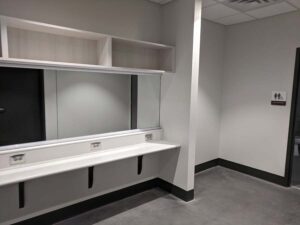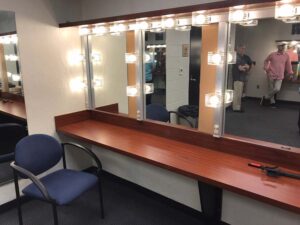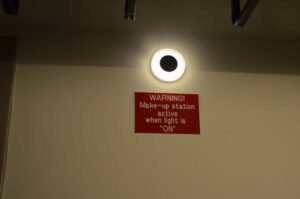Did You Know – Dressing Room Power and Light
There are fewer than 200 words in the National Electrical Code (NFPA 70 – 2020) in regard to dressing and makeup rooms, but it’s amazing how often those words seem to be misapplied. Walk into a theatre or other performing arts facility with dressing rooms and it seems more often than not the lights or power outlets around the makeup mirrors do not comply with the electrical code. It should not be this hard.

Updated makeup stations with High CRI LED lighting extrusion at top and base of mirror. Photo by Kurt Wehmann.
Building codes are about life safety, primarily protecting occupants from injury or death, and secondly about property protection. For years the International Building Code (IBC) has required fire separation between the stage and dressing rooms (IBC-2018 410.4.1), recognizing the obvious risk of fire in each of these areas. Dressing rooms must even be separated from each other (IBC-2018 410.4.2). Dressing rooms can be chaotic, filled with costumes and heat producing devices such as incandescent lights (still), hair dryers, curling irons, clothes irons, coffee makers, and the like. Performers are in a hurry and focused on their work. This can be a recipe for a fire.
See also Doing Right by the Dressing Rooms
Looking back to at least 1968’s version of the National Electrical Code (NEC), which can be read online, there have been requirements for both the lamps (light bulbs) around the dressing mirrors and the receptacles. The code has evolved over the years, with revisions in 1999 and 2017.
There are typically lights around the makeup mirror to help performers better see their faces while applying makeup. Until recently, the state of the art was incandescent lamps, which have similar color rendering to the quartz lighting used on stage. Of course, LED stage lighting is a fact of life today, prompting many to specify high CRI LED lighting around makeup mirrors. The current NEC requires all exposed lamps in dressing or makeup areas to include a permanently affixed lamp guard in 520.72. So, assuming your makeup stations use those ubiquitous single lamps, whether LED or incandescent, cages are needed. Today many designers are using LED lighting without exposed lamps and thus likely avoid this requirement.
The next part is where most of the mistakes happen. Through the 2014 version of the NEC, paragraph 520.73 addressed the switches and pilot lights required for these spaces. In 2017 the language was expanded, separating the requirements into two paragraphs with the addition of 520.74. First, the lamps and receptacles adjacent to the mirror (preferably above the counter!) must be switched inside the room. Second, there must be a pilot light outside the room for each switch.
The reason is even if the door is locked, staff can walk by the room and know if those outlets, and possibly a connected heat-producing appliance, is energized. 520.74 also added the requirement for identification of the pilot light(s), helpfully telling users what the light means.That’s it. Of course, engineers and contractors need to read and understand the Code to apply it correctly (and this missive does not substitute for proper study of the NEC). But it’s not so complicated to design safe and compliant makeup spaces.
By Paul Sanow, ASTC
Disclaimer: Any views or opinions expressed in this article are solely those of the author and do not necessarily represent those of the American Society of Theatre Consultants. This article is for general information only and should not be substituted for specific advice from a Theatre Consultant, Code Consultant, or Design Professional, and may not be suitable for all situations nor in all locations.




